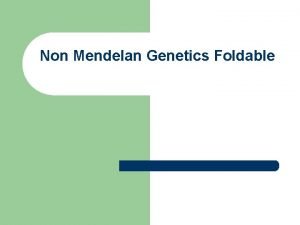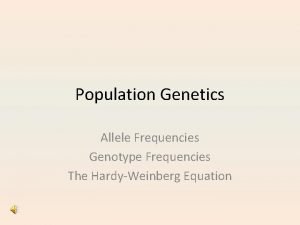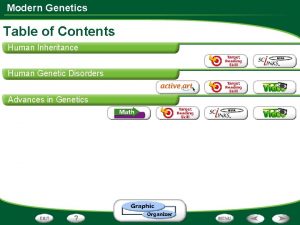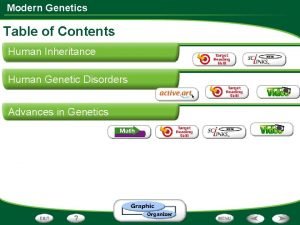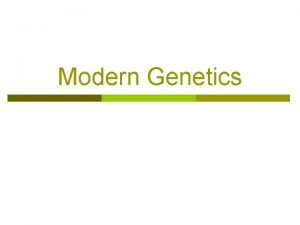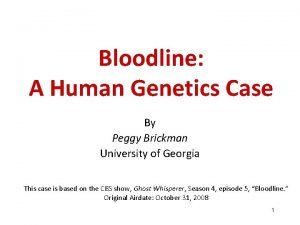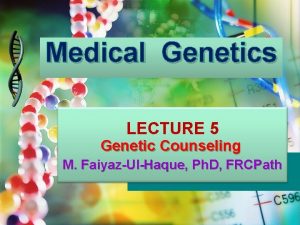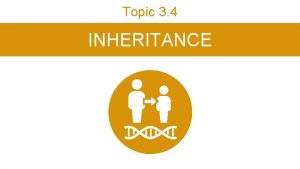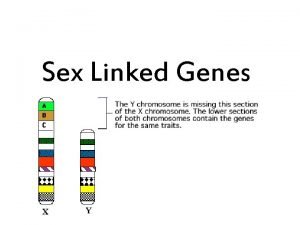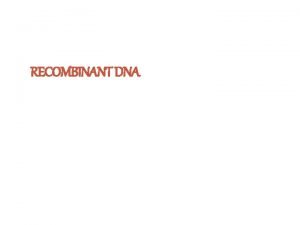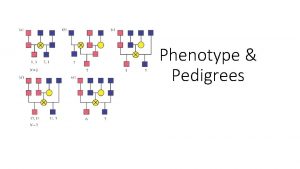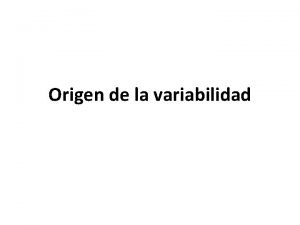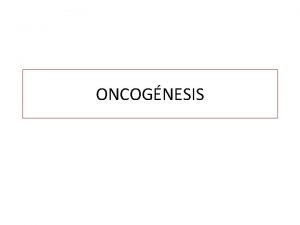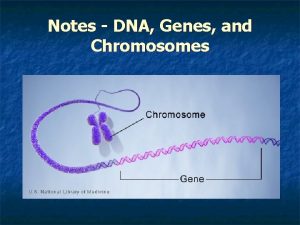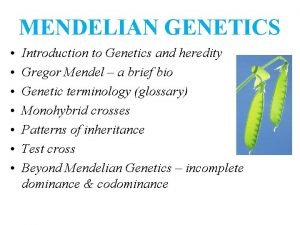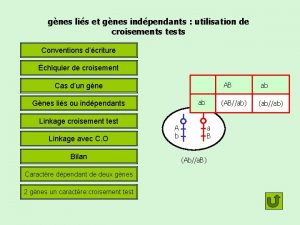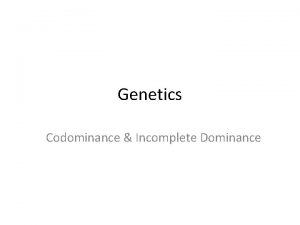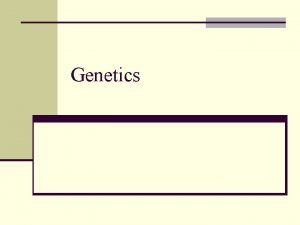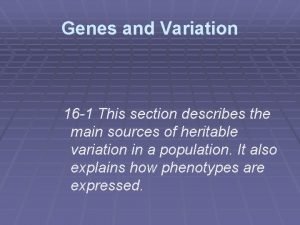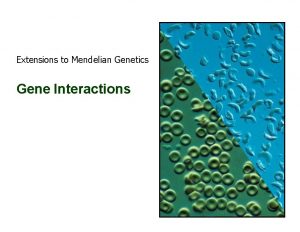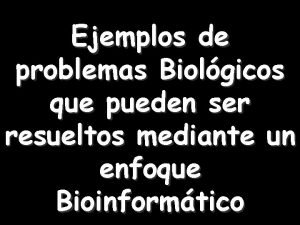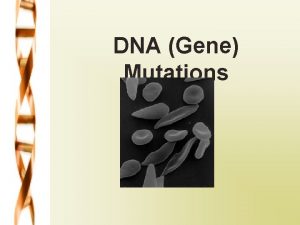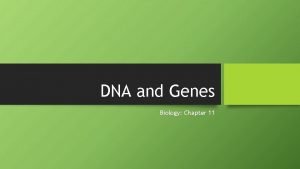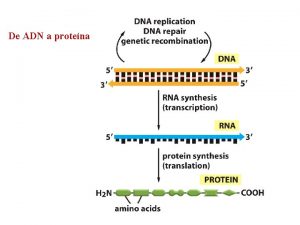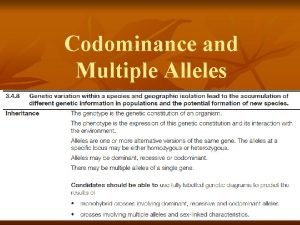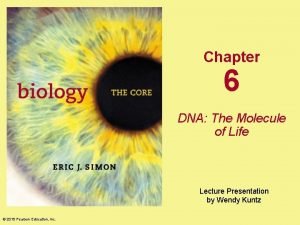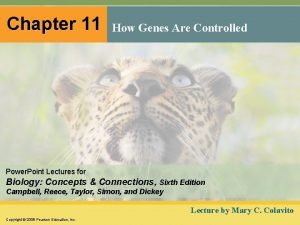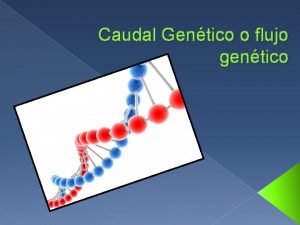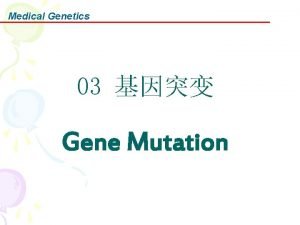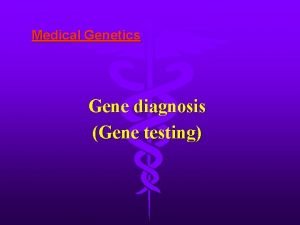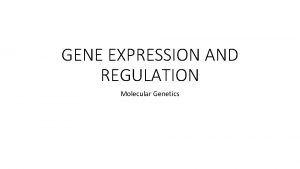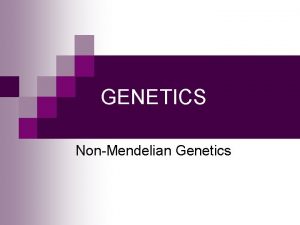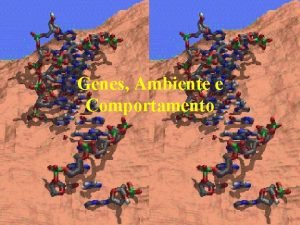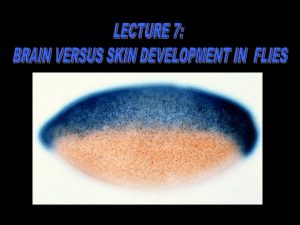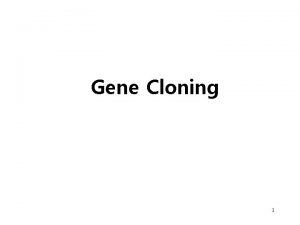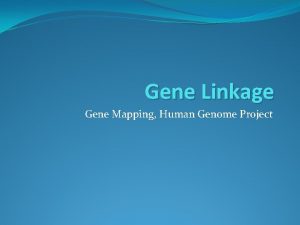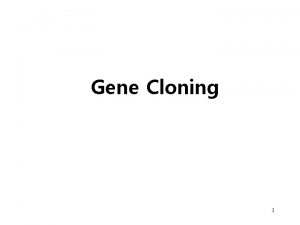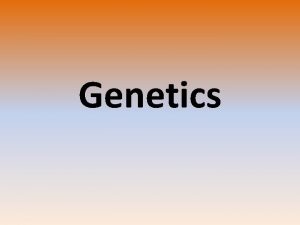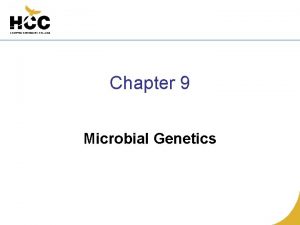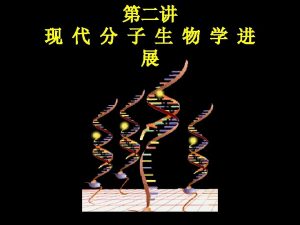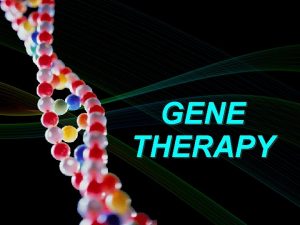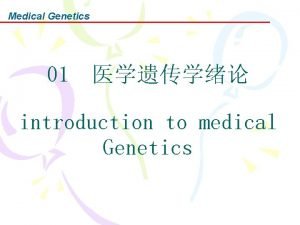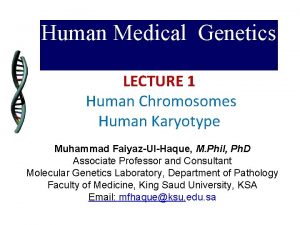Medical Genetics 02 human gene Medical Genetics Genes


















































- Slides: 50

Medical Genetics 02 人类基因 human gene

Medical Genetics Genes are entities that parents pass to offspring during reproduction.

Medical Genetics These entities encode information essential for the construction and regulation of proteins (such as enzymes) and other molecules that determine the growth and functioning of the organism.

Medical Genetics 1. Gene Chemistry Composed as a "double helix" - two linked chemical strands.

Medical Genetics Linked together by base pairs that can assume one of four variant forms: thymine (T) guanine (G) adenine (A) cytosine (C)

Medical Genetics James Watson and Francis Crick display their newly discovered model of DNA, the molecular basis of genetics.

Medical Genetics Base sequence form the "genetic code" that initiates the two major functions of genes: protein systhesis and replication.

Medical Genetics

Medical Genetics 2. Gene Structure Richard J. Roberts and Phillip A. Sharp (1993 Nobel Prize winner) made their amazing discovery of the existence of split genes in the adenovirus, when they examined a hybridized nucleic acid molecule made between a adenoviral m. RNA and its template DNA in the electron microscope.

Medical Genetics They observed that the m. RNA was much shorter in length and thus was not encoded as an equal colinear segment of the DNA molecule. Instead, large loops of unhybridized DNA (A, B and C in figure) were seen. Their interpretation was that the mature messenger RNA was derived from four discountinuous segments on the viral DNA.

Medical Genetics The segments retained in the m. RNA they called exons and the intervening sequences (A, B and C), which are excised during m. RNA processing and maturation, are called introns.

Medical Genetics

Medical Genetics

Medical Genetics

Medical Genetics

Medical Genetics GT-AG rule The predominance of this 'GTAG' rule supports the hypothesis that spliceosomal introns are spliced in yeasts, as in most eukaryotes, by a conserved mechanism.

Medical Genetics

Medical Genetics 2. Human Genome A genome is all the DNA in an organism, including its genes. Genes carry information for making all the proteins required by all organisms. These proteins determine, among other things, how the organism looks, how well its body metabolizes food or fights infection, and sometimes even how it behaves.

Medical Genetics

Medical Genetics Simple Sequence DNA All eukaryotes have more than one type of simple sequence DNA. The repeat unit length is usually 5 -10 bp but may be as short as 2 or as long as 200. These repeat units are arranged in head to tail tandem arrays which vary in length. The longest tandem array known so far is that of human alphoid DNA which has a total array length of approximately 5 million base pairs but certain simple sequences have an array length of only a few hundred base pairs.

Medical Genetics Most simple sequence DNA is found in heterochromatin - particularly at the centromere and at the ends or telomeres of chromosomes - though some simple sequences are scattered at different positions on different chromosomes.

Medical Genetics Some simple sequence families form the basis for DNA fingerprinting. These families are called minisatellites. Minisatellites have a repeat unit length of 15 -100 bp and a total array length of 0. 5 to 30 kb. The short array length is the reason they are called minisatellites to distinguish them from normal satellite DNA which has array lengths in the range of a few hundred kb.

Medical Genetics

Medical Genetics Microsatellite DNA differs from minisatellite DNA in that the repeat units are less than 5 bp in length for example (TG)n or (AAT)n. These microsatellites are highly polymorphic in the length of their repeat arrays and so they can also be used in forensic analysis, as well as to identify related groups of individuals within populations.

Medical Genetics The advantage of microsatellites over minisatellites is that the size of each allele is much smaller and they are therefore more amenable to PCR analysis. Their small size also means that they are more likely to remain intact in highly degraded DNA such as that from forensic samples or from ancient DNA - for example from Egyptian mummies.

Medical Genetics Microsatellites are also involved in a number of human genetic diseases which have been shown to be due to variations in the numbers of trinucleotide repeats.

Medical Genetics Human genome project Collective name (Human Genome Initiative ) for several projects begun in 1986 by DOE to create an ordered set of DNA segments from known chromosomal locations, develop new computational methods for analyzing genetic map and DNA sequence data, and develop new techniques and instruments for detecting and analyzing DNA. This DOE initiative is now known as the Human Genome Program. The joint national effort, led by DOE and NIH, is known as the Human Genome Project.

Medical Genetics Begun formally in 1990, the U. S. Human Genome Project was a 13 year effort coordinated by the U. S. Department of Energy and the National Institutes of Health. The project originally was planned to last 15 years, but rapid technological advances accelerated the completion date to 2003.

Medical Genetics • identify all the approximately 20, 000 -25, 000 genes in human DNA, • determine the sequences of the 3 billion chemical base pairs that make up human DNA, • store this information in databases, • improve tools for data analysis, • transfer related technologies to the private sector, and • address the ethical, legal, and social issues (ELSI) that may arise from the project.

Medical Genetics 3. DNA replication Before a cell can divide, it must duplicate all its DNA. In eukaryotes, this occurs during S phase of the cell cycle.

Medical Genetics The Steps: 1. A portion of the double helix is unwound by a helicase. 2. A molecule of a DNA polymerase binds to one strand of the DNA and begins moving along it in the 3' to 5' direction, using it as a template for assembling a leading strand of nucleotides and reforming a double helix. In eukaryotes, this molecule is called DNA polymerase delta (δ).

Medical Genetics 3. Because DNA synthesis can only occur 5' to 3', a molecule of a second type of DNA polymerase (epsilon, ε, in eukaryotes) binds to the other template strand as the double helix opens. This molecule must synthesize discontinuous segments of polynucleotides (Okazaki fragments). Another enzyme, DNA ligase I then stitches these together into the lagging strand.

Medical Genetics

Medical Genetics When the replication process is complete, two DNA molecules — identical to each other and identical to the original — have been produced. Each strand of the original molecule has • remained intact as it served as the template for the synthesis of • a complementary strand. This mode of replication is described as semiconservative: one-half of each new molecule of DNA is old; one-half new.

Medical Genetics

Medical Genetics 4. Gene Expression The majority of genes are expressed as the proteins they encode. The process occurs in two steps: Transcription = DNA → RNA Translation = RNA → protein Taken together, they make up the "central dogma" of biology: DNA → RNA → protein.

Medical Genetics Here is an overview

Medical Genetics Gene Transcription: DNA → RNA DNA serves as the template for the synthesis of RNA much as it does for its own replication.

Medical Genetics Some 50 different protein transcription factors bind to promoter sites, usually on the 5′ side of the gene to be transcribed. An enzyme, an RNA polymerase, binds to the complex of transcription factors. Working together, they open the DNA double helix. The RNA polymerase proceeds down one strand moving in the 3′ → 5′ direction. In eukaryotes, this requires — at least for proteinencoding genes — that the nucleosomes in front of the advancing RNA polymerase (RNAP II) be removed. A complex of proteins is responsible for this. The same complex replaces the nucleosomes after the DNA has been transcribed and RNAP II has moved on.

Medical Genetics As the RNA polymerase travels along the DNA strand, it assembles ribonucleotides into a strand of RNA. Each ribonucleotide is inserted into the growing RNA strand following the rules of base pairing. Thus for each C encountered on the DNA strand, a G is inserted in the RNA; for each G, a C; and for each T, an A. However, each A on the DNA guides the insertion of the pyrimidine uracil. There is no T in RNA. Synthesis of the RNA proceeds in the 5′ → 3′. As each nucleoside triphosphate is brought in to add to the 3′ end of the growing strand, the two terminal phosphates are removed. When transcription is complete, the transcript is released from the polymerase and, shortly thereafter, the polymerase is released from the DNA.

Medical Genetics Types of RNA m. RNA. This will later be translated into a polypeptide. r. RNA. This will be used in the building of ribosomes: machinery for synthesizing proteins by translating m. RNA. t. RNA molecules that carry amino acids to the growing polypeptide. sn. RNA (small nuclear RNA ). DNA transcription of the genes for m. RNA, r. RNA, and t. RNA produces large precursor molecules ("primary transcripts") that must be processed within the nucleus to produce the functional molecules for export to the cytosol. Some of these processing steps are mediated by sn. RNAs. sno. RNA (small nucleolar RNA ). These RNAs within the nucleolus have several functions (described below). mi. RNA (micro. RNA). These are tiny (~22 nts) RNA molecules that appear to regulate the expression of messenger RNA (m. RNA) molecules. [Discussion] XIST RNA. This inactivates one of the two X chromosomes in female vertebrates.

Medical Genetics Small Nuclear RNA (sn. RNA) Approximately a dozen different genes for sn. RNAs, each present in multiple copies, have been identified. The sn. RNAs have various roles in the processing of the other classes of RNA. For example, several sn. RNAs are part of the spliceosome that participates in converting pre-m. RNA into m. RNA by excising the introns and splicing the exons.

Medical Genetics Small Nucleolar RNA (sno. RNA) As the name suggests, these small (60– 300 nts) RNAs are found in the nucleolus where they are responsible for several functions: • Some participate in making ribosomes by helping to cut up the large RNA precursor of the 28 S, 18 S, and 5. 8 S molecules. • Others chemically modify many of the nucleotides in r. RNA, t. RNA, and sn. RNA molecules, e. g. , by adding methyl groups to ribose. • Some have been implicated in the alternative splicing of pre-m. RNA to different forms of mature m. RNA. • One sno. RNA serves as the template for the synthesis of telomeres

Medical Genetics RNA Processing: pre-m. RNA → m. RNA All the primary transcripts produced in the nucleus must undergo processing steps to produce functional RNA molecules for export to the cytosol. We shall confine ourselves to a view of the steps as they occur in the processing of pre-m. RNA to m. RNA.

Medical Genetics

Medical Genetics Gene Translation: RNA -> Protein By means of transfer RNA molecules, each specific for one amino acid and for a particular triplet of nucleotides in m. RNA called a codon. The family of t. RNA molecules enables the codons in a m. RNA molecule to be translated into the sequence of amino acids in the protein.

Medical Genetics The Steps of Translation 1. Initiation 2. Elongation 3. Termination

Medical Genetics

Medical Genetics RNA Interference Here small RNA molecules bind to the complementary portion of a m. RNA and prevent it from being translated by ribosomes or trigger its destruction.

Medical Genetics
 Linked genes and unlinked genes
Linked genes and unlinked genes Glomerulus
Glomerulus Polygenic inheritance
Polygenic inheritance Chromosomes genes and basic genetics foldable answer key
Chromosomes genes and basic genetics foldable answer key Gene by gene test results
Gene by gene test results Chapter 17 from gene to protein
Chapter 17 from gene to protein Gene frequency
Gene frequency Genetic effects on gene expression across human tissues
Genetic effects on gene expression across human tissues Human inheritance modern genetics answer key
Human inheritance modern genetics answer key Human clone
Human clone Modern genetics human inheritance answer key
Modern genetics human inheritance answer key 14-3 human molecular genetics answer key
14-3 human molecular genetics answer key Human genetics concepts and applications 10th edition
Human genetics concepts and applications 10th edition Peggy brickman
Peggy brickman Genetic counseling definition
Genetic counseling definition Citrullinemia type 2
Citrullinemia type 2 Hemizygous definition biology
Hemizygous definition biology Sex linked traits
Sex linked traits Stabilizing selection human birth weight
Stabilizing selection human birth weight Complementary genes example
Complementary genes example Punnett square for o blood type
Punnett square for o blood type Codominant genes
Codominant genes Flujo de genes ejemplos
Flujo de genes ejemplos Telomerasa
Telomerasa Chromosome vs dna vs gene
Chromosome vs dna vs gene Codominace
Codominace Flujo genetico
Flujo genetico Linked genes
Linked genes Levi genes
Levi genes Learn genetics utah karyotype
Learn genetics utah karyotype Genes located
Genes located échiquier de croisement gènes liés
échiquier de croisement gènes liés Genes ligados
Genes ligados Incomplete dominance horses
Incomplete dominance horses Bill nye genes worksheet answers
Bill nye genes worksheet answers Genetics is the study of heredity
Genetics is the study of heredity Genes in a bottle
Genes in a bottle 16-1 genes and variation
16-1 genes and variation Complementary gene action
Complementary gene action Los transposones son genes móviles en un cromosoma
Los transposones son genes móviles en un cromosoma Genes xenologos
Genes xenologos What causes mutation
What causes mutation Chapter 11 dna and genes
Chapter 11 dna and genes Genes estructurales
Genes estructurales Codominant allele
Codominant allele Genes on chromosome 11
Genes on chromosome 11 The age of genes chapter 6
The age of genes chapter 6 Evolution of populations section 16-1 genes and variation
Evolution of populations section 16-1 genes and variation Section 16-1 genes and variation
Section 16-1 genes and variation Chapter 11: how genes are controlled
Chapter 11: how genes are controlled Caudal genetico
Caudal genetico



